
Our Portuguese Courses in Portugal click below :
- Faro
- Lisbon
10 millions
 National Anthem National Anthem
 Early History Early History
Due to Portugal's pleasant climate, plentiful game and fish from the coast and rivers, this part of the Iberian peninsula supported a flourishing population in prehistoric times. Very few traces of this culture remain. Portugal was colonized by a whole range of civilisations, the first one being the Celts who settled the Iberian Peninsula around 700BC. After the Celts, the Phoenicians traded from the site of present-day Lisbon and the Carthaginians and Greeks set up trading posts along the southern coastline.
After the Second Punic War (218 to 202BC) when the Iberian peninsula was annexed by the Romans, the region came under a kind of unified control for the first time. Despite the subsequent colonisation of much of the country and the building of roads, aqueducts and elegant bridges, very few remnants of the Roman period can be seen in modern Portugal. The main Roman contribution was the system of vast agricultural estates established in the Alentejo and the introduction of new crops that were to become the mainstays of the Portuguese economy, namely wheat, barley, olives and grapes. At the onset of the 5th century AD the Iberian Penninsula was invaded by Germanic tribes. The Visigoths imposed their rule but in the north of the region the Suevi established a kingdom that lasted until late in the 6th century when they too came under the rule of the Visigoths. In 711AD the Visigoths were in turn defeated by the Moors.
The Moors
During the 8th century, the Moors crossed the Straits of Gibraltar and invaded the Iberian Peninsula. This invasion had a lasting effect on the country, as the Moors introduced their culture, architecture and agricultural techniques to Portugal. In the South of Portugal, place names and people's features still act as reminders of these times. Moorish rule lasted until the 12th century, when Christian forces moved
south and overran the Moorish towns and castles.
The leader of the Christian forces, Afonso Henriques, was now called the first king of all Portugal. Numerous cathedrals were built to commemorate their victories over the Moors. By the mid 13th century, the Christian conquest was complete, and fledgling kingdoms of Portugal extended to its current borders.
The Age of Discovery, and Napoleon
Once the kingdom of Portugal was established, the Portuguese kings turned their attention to maritime adventures that would provide them with great colonial wealth. Prince Henry the Navigator started a famous school of navigation and launched the Age of Discovery.
These adventurers led expeditions into Africa looking for wealth and glory, as well as a mysterious messianic figure named Prester John, the ruler of a Christian paradise. Bartolomeu Dias rounded the Cape
of Good Hope in 1487, and in 1498, Vasco da Gama reached Calcutta. Portugal established numerous colonies along the East African and Indian coasts and Pedro Alvares Cabral sailed to Brazil. The Portuguese Empire had spread over four continents by the mid
16th century. The wealth of the empire was boundless and Portugal was at the height of its influence, but the glory was not to last and the country became debt-ridden. Portugal then came under Spanish rule, a situation which was to last for a period of 60 years.
By 1640, the Portuguese took back the throne when a member of the House of Braganca was instated. Joao IV was, however, merely an enlightened
despot who squandered money on massive, flamboyant architectural projects. Later on in 1807 when Napoleon's army invaded Portugal, the royal family fled to Brazil and only returned when the French
were driven out in 1821. As the empire disintegrated with Brazil's declaration of independence, and with in-court fighting, the Portuguese monarchy was doomed.
Recent History
By 1910 the monarchy was abolished and a republic was founded. In 1926 the democratic phase was ended by a military coup which introduced the dictatorship of Antonio de Oliveira Sabazar, which lasted until 1968. General dissatisfaction led to a peaceful military coup in April 1974. During the 1970s and 80s, Portugal's political scene experienced extreme swings between right and left and the economy suffered due to strikes and land ownership disputes. Entry into the EU in 1986 secured a measure of stability, which has been helped along by the acceptance of Portugal as a full member of the European Monetary System in 1992.
The Portuguese climate is temperate. It is extremely hot only in midsummer in the Algarve and Alentejo, but is very pleasant along the coast, where an evening breeze cools the temperature down. The tourist season begins in spring (late February) and continues throughout the autumn (November). In the Algarve, springtime begins in February with a beautiful display of wild flowers. During September and October, Indian summer occurs and this ensures that the sun still shines warmly in November. During winter the temperatures are mild and it rains frequently, especially in the north. The only area which does not receive a lot of rain is Madeira, where the winter season is always very popular.
The average daily minimum and maximum temperatures for Lisbon during January are 6°C and 14°C (43°F and 57°F). During July, the average minimum temperature is 17°C (63°F), while the average maximum is 27°C (81°F). The average yearly rainfall for Portugal is between 510mm (20 inches) and 1,000mm (39 inches). In Lisbon, the number of days during which precipitation can be recorded averages 15 in January and two in July. In Porto, the average is 18 days in January and five in July. Snowfall does occur in the mountains, particularly Serra da Estrela which has basic ski facilities. The tourist season in the north of Portugal lasts from May until September.
Portuguese
National 's Day : June 10 The standard current is 220 volts AC, 50 Hz, and plugs are generally of the two pin round type, thus you may need an adapter plug and a voltage converter that fits the standardised plug outlets.
Electricity in Madeira is supplied at 220 volts, AC, at 50 Hz. The round variety of two-pin plugs is used.
Euro
- Canadian visitors please consult this handy site Travel information and advisory reports
- For all other nationals please consult your Mexican embassy or consulate in your country of origin
Large portions and excellent value for money are to be expected in a country where eating and drinking receive such serious attention. Lunch is a very leisurely affair, and lasts between noon and 15:00, while evening meals are normally eaten between 19:00 and 10:30.
The seafood in Portugal is excellent, especially the fish such as sole, tuna and cod. Also worth trying is the ham from the Chaves region and lamb from Alentejo. Portugal has a range of desserts and cakes. Coffee is very popular and is served either as a black espresso, or with lots of milk. Beer is very popular and local brands include Sagres, Super Bock and Tuborg. Wine comes in three forms, red, white and sparkling, and is excellent. Port is produced near Porto, in north-western Portugal, and also comes in three forms: ruby, tawny and white.
Picado
500 g beef in cubes
Butter for frying
Salt
4 garlic cloves, chopped
3-4 drops of piri-piri sauce (or minced chilli pepper)
Red wine
1/4 bouillon cube
1 table spoon tomato ketchup
Put butter in a frying pan on medium heat. Add beef, a bit salt, piri-piri and garlic. Let cook for 4-5 minutes while stirring. Move the beef to a deep serving dish. Leave the liquid in the frying pan. Add to the frying pan a bit red wine, the bouillon and the tomato ketchup. Stir and cook for 1 minute. Pour the sauce over the beef. Serve with French fries, a green salad and maybe some white bread
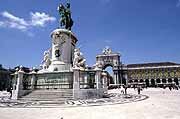
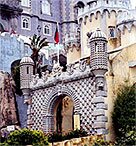
|
 |

 Occupying the western Iberian peninsula in south-western Europe, the Republic of Portugal borders on the Atlantic Occupying the western Iberian peninsula in south-western Europe, the Republic of Portugal borders on the Atlantic
Ocean, with Spain to the north and to the east. One of the smallest European states, Portugal occupies approximately 16° of the peninsula.
The capital is Lisbon, which is situated on the coast. The official language is Portuguese but in the larger cities such as Lisbon and Porto, it is easy to find English-speaking Portuguese.
The same does not apply to the more remote areas.
Portugal is a land of natural grandeur and colour, with a
sweeping coastline and a green, mountainous interior.
It is divided into two different geographical regions; the northern region is mountainous with a rainy, fairly cool climate while the southern region is drier and warmer with rolling plains. Portugal is a country of diversity, offering a wide range of activities for visitors. It has beautiful beaches and historic towns; typical Portuguese architecture can still be found alongside the more modern architecture which has sprung up due to the recent economic growth.
Portugal lends itself to a whole range of outdoor activities:
tennis, golf, water sports, hiking, horse riding, and,
during winter, skiing in the northern mountains.
Madeira is a collection of five volcanic islands off the coast of North Africa. A semi-autonomous region of Portugal, the islands are famous for their exquisite beauty and their fortified wine. Lush green forests, sculptured rock gardens carefully cultivated over the centuries by attentive residents, and sprawling fruit farms and vineyards make this island a treasure of the Atlantic.The Azores (Açores), a group of 9 islands in the Atlantic Ocean, 1,448km (900 miles) west of Portugal's mainland are, administratively, an autonomous region
of this country. The largest of these islands, São Miguel,
has some breathtaking scenery and is thus the most visited of the group.
Lisbon
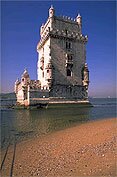 Situated on the River Tagus where it broadens and joins the Atlantic Ocean Lisbon, Portugal's capital city, has one of Europe's best and busiest harbours. Set on 7 terraced hills, this is a beautiful, atmospheric city with a low skyline and interesting blend of architectural styles. The city maintains the black and white mosaic sidewalks, pastel facades and cobbled medieval alleys, some of which are barely an arm's length wide. These serve to provide a marvellous ambience for the visitor, a glimpse of a world now long gone. Streetcars still run down the broad avenues and narrow lanes, and a detailed map is a necessity as the twisty streets change names frequently. The redeveloped riverside area between Santos and Alcantara has many bars and converted warehouses. In Lisbon you can while away the time at one of the many outdoor cafés, watching the trams and life go by and not have to worry that it's costing you an arm and a leg: this charming city is still one of Western Europe's most affordable capitals. Situated on the River Tagus where it broadens and joins the Atlantic Ocean Lisbon, Portugal's capital city, has one of Europe's best and busiest harbours. Set on 7 terraced hills, this is a beautiful, atmospheric city with a low skyline and interesting blend of architectural styles. The city maintains the black and white mosaic sidewalks, pastel facades and cobbled medieval alleys, some of which are barely an arm's length wide. These serve to provide a marvellous ambience for the visitor, a glimpse of a world now long gone. Streetcars still run down the broad avenues and narrow lanes, and a detailed map is a necessity as the twisty streets change names frequently. The redeveloped riverside area between Santos and Alcantara has many bars and converted warehouses. In Lisbon you can while away the time at one of the many outdoor cafés, watching the trams and life go by and not have to worry that it's costing you an arm and a leg: this charming city is still one of Western Europe's most affordable capitals.
Lisbon owes its initial growth and prestige to its location overlooking a splendid and protected harbour. As far back as the 12th century BC, Phoenician sailors were attracted by the harbour and constructed the first settlement atop São Jorge, the steepest section of what was to become Lisbon.
The city's harbour rose to prominence again in the 16th century, when Portugal embarked on its great voyages of discovery. Vasco da Gama sailed to India from Lisbon in 1497 and ensured the country a near monopoly on eastern spices. This ushered in the golden age of Portugal. For the next two centuries, Lisbon enjoyed greater revenues than any other city on the entire European continent.
Catastrophe hit Lisbon in 1755 while most of its citizens were collected in churches celebrating All Saints' Day. The most disastrous earthquake ever to hit a European city was felt as far away as Scotland. A terrible tidal wave in the aftermath of the quake killed many more inhabitants. A third of the population perished. Damaged buildings were torn down and the first rational urban renewal campaign on the continent was begun.
Towards the end of the 20th century Portugal's colonies of Angola, Cape Verde, Guinea and Mozambique gained their independence. The country incorporated 750 000 retornados (people of Portuguese descent returning from independent Africa to their official homeland). Lisbon's population increased by 10% as a result of this but, today, is still western Europe's smallest capital.
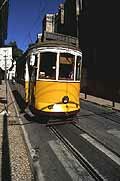
What to see and what to do Sports
 Portugal offers a wide range of sports and sporting facilities. Most hotels and resorts have clay tennis courts. Sailing, boating, windsurfing and other water sports are very popular along the Atlantic and Mediterranean coasts. Yachting and sailing facilities are found at Cascais Yacht club, the marinas in Lisbon and at the expanding Vilamoura Marina in the Algarve. Portugal's rivers, streams and coastline make the country a fisherman's dream. Golf can be practised all year round and the courses in Lisbon and the Algarve are said to be the best on the Continent. Portugal also offers hiking, and horse riding along sandy beaches, along mountain trails and through small villages. Portugal offers a wide range of sports and sporting facilities. Most hotels and resorts have clay tennis courts. Sailing, boating, windsurfing and other water sports are very popular along the Atlantic and Mediterranean coasts. Yachting and sailing facilities are found at Cascais Yacht club, the marinas in Lisbon and at the expanding Vilamoura Marina in the Algarve. Portugal's rivers, streams and coastline make the country a fisherman's dream. Golf can be practised all year round and the courses in Lisbon and the Algarve are said to be the best on the Continent. Portugal also offers hiking, and horse riding along sandy beaches, along mountain trails and through small villages.
Soccer is Portugal's most popular sport. It dominates the sporting scene; everything stops when the national team is playing a major game. The football season lasts from August until May and every village and town tries to find enough players to make up their own team. The main teams are Lisbon's Benfica, Sporting and Porto's FC Porto. The country regularly produces world-class quality players, such as Luis Figo, that are headhunted by Europe's top clubs.
The bullfighting season lasts from late April to October. Although the rules do not allow for a public kill, the bulls often have to be killed after a fight. Ribatejo is the main bull breeding region, and major fights are staged in Ribatejo Vila Franca da Xira and Santarem
Shopping
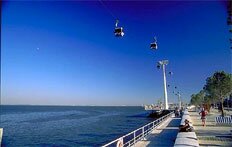 Portugal offers a whole range of goods which are well made and offer fairly good value for money. Woven baskets, beautiful hand-embroidered table linens and blouses are sold at markets and in gift shops. Traditional embroidered silk bedspreads are made in Castelo Branco and excellent, hand-made lace can be bought near Porto. Handicrafts range from inexpensive pottery to more substantial purchases like Arraiolos rugs, filigree gold or silver jewellery and leather goods such as shoes and bags. Alantejo's cork is made into picture frames, lidded buckets and a whole range of other goods.There are a few things Madeira is famous for, such as its exquisite embroidery and wicker work. But, nothing compares to the renowned Madeira Wine. Portugal offers a whole range of goods which are well made and offer fairly good value for money. Woven baskets, beautiful hand-embroidered table linens and blouses are sold at markets and in gift shops. Traditional embroidered silk bedspreads are made in Castelo Branco and excellent, hand-made lace can be bought near Porto. Handicrafts range from inexpensive pottery to more substantial purchases like Arraiolos rugs, filigree gold or silver jewellery and leather goods such as shoes and bags. Alantejo's cork is made into picture frames, lidded buckets and a whole range of other goods.There are a few things Madeira is famous for, such as its exquisite embroidery and wicker work. But, nothing compares to the renowned Madeira Wine.
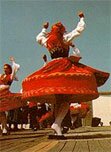 Nightlife Nightlife
The major cities of Portugal have a good night life scene. In Lisbon the Av. 24 Julho is the best place to head for if its bustling night clubs you're after. There are plenty of trendy bars here as well. Doca de Sto and Bairro Alto are also lively areas after sunset, although the latter has a reputation as the capital's alternative quarter.
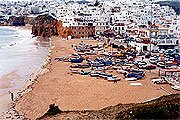
|


